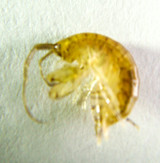Life Cycle
The Copepoda are the largest class of crustaceans forming an important link between phytoplankton and higher trophic levels in most aquatic ecosystems. Most adult copepods have a length between 1 and 5 mm. The body of most copepods is cylindriconical in shape, with a wider anterior part. The trunk consists of two distinct parts, the cephalothorax (the head being fused with the first of the six thoracic segments) and the abdomen, which is narrower than the cephalothorax. The head has a central naupliar eye and unirameous first antennae that are generally very long.
Planktonic copepods are mainly suspension feeders on phytoplankton and/or bacteria; the food items being collected by the second maxillae. As such, copepods are therefore selective filter-feeders. A water current is generated by the appendages over the stationary second maxillae, which actively captures the food particles.
The male copepods are commonly smaller than the females and appear in lower abundance then the latter. During copulation the male grasps the female with his first antennae, and deposits the spermatophores into seminal receptacle openings, where they are glued by means of a special cement. The eggs are usually enclosed by an ovisac, which serves as a brood chamber and remains attached to the female’s first abdominal segment. Calanoids shed their eggs singly into the water. The eggs hatch as nauplii and after five to six naupliar stages (moltings), the larvae become copepodites. After five copepodite moltings the adult stage is reached and molting is ceased. The development may take from less than one week to as long as one year, and the life span of a copepod ranging from six months to one year.
Under unfavourable conditions some copepod species can produce thick-shelled dormant eggs or resting eggs. Such cysts can withstand desiccation and also provide means for dispersal when these are carried to other places by birds or other animals. In more northern regions a diapause stage is present in the development of the copepods so as to survive adverse environmental conditions, such as freezing; such a diapause usually taking place between the copepodite stage II to adult females and recognised by an empty alimentary tract, the presence of numerous orange oil globules in the tissue and an organic, cyst-like covering. The major diapause habitat is the sediment, although a minor part of the diapausing individuals may stay in the planktonic fraction, the so-called “active diapause”.
Life cycle
Copepods are a holoplankton species, meaning they stay planktonic for all of their lifecycle. During mating, the male copepod grips the female with his first pair of antennae, which is sometimes modified for this purpose. The male then produces an adhesive package of sperm and transfers it to the female's genital opening with his thoracic limbs. Eggs are sometimes laid directly into the water, but many species enclose them within a sac attached to the female's body until they hatch. In some pond-dwelling species, the eggs have a tough shell and can lie dormant for extended periods if the pond dries up.
Eggs hatch into nauplius larvae, which consist of a head with a small tail, but no thorax or true abdomen. The nauplius moults five or six times, before emerging as a "copepodid larva". This stage resembles the adult, but has a simple, unsegmented abdomen and only three pairs of thoracic limbs. After a further five moults, the copepod takes on the adult form. The entire process from hatching to adulthood can take a week to a year, depending on the species.
You can introduce live copepods to your aquarium coral reef tank in mixed dense cultures like "Reef Soup" or in individual bulk cultures.
Wikipedia
